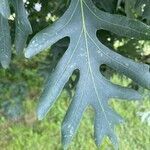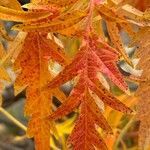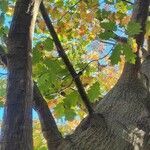Trees , deciduous, to 30 m; lower trunk without stubs of dead branches. Bark dark gray to dark brown, irregularly fissured with scaly ridges, inner bark orangish pink. Twigs reddish brown, (1-)2-3.5 mm diam., glabrous. Terminal buds dark reddish brown, conic to ovoid, 4-7 mm, noticeably 5-angled in cross section, usually silvery-or tawny-pubescent distal to middle. Leaves: petiole 25-60 mm, glabrous. Leaf blade elliptic to ovate or obovate, 70-160 × 80-130 mm, base obtuse to truncate, margins with 5-9 deep lobes and 18-50 awns, lobes distally expanded, sinuses usually extending more than 1/2 distance to midrib, apex acute; surfaces abaxially glabrous except for minute axillary tufts of tomentum, adaxially glossy light green, glabrous, secondary veins raised on both surfaces. Acorns biennial; cup turbinate to hemispheric, 7-13 mm high × 16.5-31.5 mm wide, covering 1/3-1/2 nut, outer surface light to dark reddish brown, glossy, glabrous to puberulent, inner surface light brown, glabrous, occasionally with ring of pubescence around scar, scales often tuberculate, base broad, glossy, margins strongly concave with tips tightly appressed, acute to attenuate; nut oblong to subglobose, 12-22 × 10-21 mm, glabrous, with 1 or more rings of fine pits at apex, scar diam. 6.5-13.5 mm. 2 n = 24.
More
A tree 20-25 m tall. It spreads 12-15 m wide. The trunk is 60-90 cm across. The bark is grey-brown. It loses its leaves during the year. The leaves are 10-15 cm long. There are 7-9 deep lobes. The leaf stalks are 4-6 cm long. The leaves are glossy and deeply divided. They are dark green but turn bright red in autumn. The acorns are 15-20 mm long. They are squat and fat. The cup encloses one half of the acorn. The scales are light reddish-brown.




